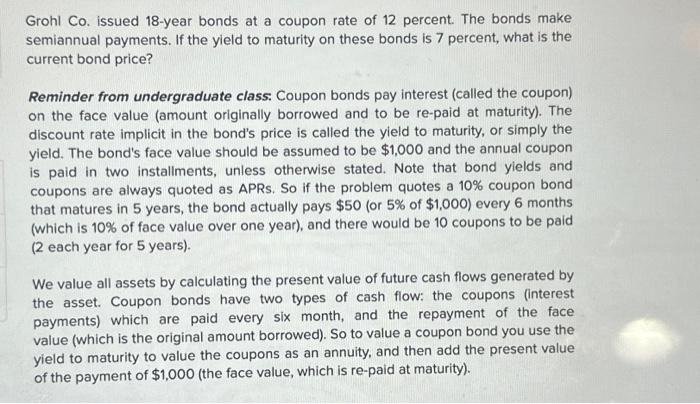Answered step by step
Verified Expert Solution
Question
1 Approved Answer
Grohl Co. issued 18-year bonds at a coupon rate of 12 percent. The bonds make semiannual payments. If the yield to maturity on these bonds
Grohl Co. issued 18-year bonds at a coupon rate of 12 percent. The bonds make semiannual payments. If the yield to maturity on these bonds is 7 percent, what is the current bond price? Reminder from undergraduate class: Coupon bonds pay interest (called the coupon) on the face value (amount originally borrowed and to be re-paid at maturity). The discount rate implicit in the bond's price is called the yield to maturity, or simply the yield. The bond's face value should be assumed to be $1,000 and the annual coupon is paid in two installments, unless otherwise stated. Note that bond yields and coupons are always quoted as APRs. So if the problem quotes a 10% coupon bond that matures in 5 years, the bond actually pays $50 (or 5% of $1,000) every 6 months (which is 10% of face value over one year), and there would be 10 coupons to be paid (2 each year for 5 years). We value all assets by calculating the present value of future cash flows generated by the asset. Coupon bonds have two types of cash flow: the coupons (interest payments) which are paid every six month, and the repayment of the face value (which is the original amount borrowed). So to value a coupon bond you use the yield to maturity to value the coupons as an annuity, and then add the present value of the payment of $1,000 (the face value, which is re-paid at maturity).

Step by Step Solution
There are 3 Steps involved in it
Step: 1

Get Instant Access to Expert-Tailored Solutions
See step-by-step solutions with expert insights and AI powered tools for academic success
Step: 2

Step: 3

Ace Your Homework with AI
Get the answers you need in no time with our AI-driven, step-by-step assistance
Get Started


